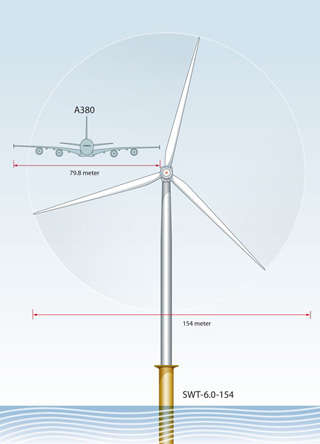Make way for renewable energy's Blade Runner
 It’s pretty impressive when you make a wind turbine with blades almost as long as a football field, and so big that the world’s largest passenger jumbo jet can fly between them. But how do you transport them from factory to their next stop, especially when the destination is hundreds of miles away?
It’s pretty impressive when you make a wind turbine with blades almost as long as a football field, and so big that the world’s largest passenger jumbo jet can fly between them. But how do you transport them from factory to their next stop, especially when the destination is hundreds of miles away?The answer, as Siemens proved in Denmark: Slowly and circuitously.
The German engineering giant had to deliver the first batch of its 246-foot blades (75 meters) from its factory in Aalborg in northern Denmark, to Nakskov in the south. For you and I that’s a 205 mile journey. For the world’s longest wind blades (at least Siemens says so), the truck had to meander nearly twice as far, or 360 miles around Denmark.
Presumably the driver and crew got to see a fair chunk of the country, which is about 280 miles across at its widest, and 230 miles up and down at its longest. The truck chugged along at an average of 37 mph.
And get this: The blades did not even end up at a wind farm. Rather, they went into a Nakskov paint shop. After a suitable coating, Siemens will have to transport them again back up north to the Osterild wind test station, where Siemens plans to erect a test turbine.
The company says in a press release that it used innovative lightweight technology to make the blades, without which they would have been “25-50 percent heavier.” It adds,
“Heavy blades are subject to higher loads and require stronger nacelles, towers, and foundations. The combination of intelligent design and low weight has a correspondingly positive effect on the power generation costs for wind energy.” (A nacelle is the part of a wind turbine that houses the gearbox and generator).

Siemens constructs the blades as one big piece without glue joints, using a process it calls IntegralBlade.
The prototype turbine will have a 6 megawatt generating capacity using 3 blades, Siemens says. That’s a lot for a single wind turbine. If you put 100 of them on one site, you’d have have a 600 megawatt power plant, or about half the size of a nuclear power station.
The blades are so large they form a diameter of over 500 feet, and the gap between them would allow an Airbus A380 to fly through, according to a Siemens diagram.
Note to pilots: Please don’t get any stunt ideas. Just enjoy the view from above.
You can return to the main Market News page, or press the Back button on your browser.

